- Details
- Hits: 1457
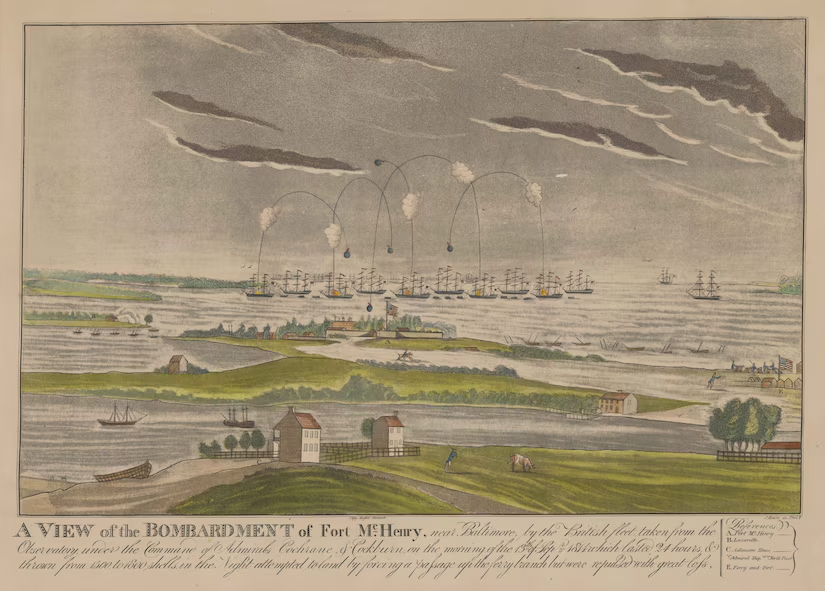 A view of the bombardment of Fort McHenry, near Baltimore, by the British fleet, taken from the observatory under the command of Admirals Cochrane and Cockburn on the morning of Sept. 13, 1814, painted by John Bower in 1819. Courtesy of the Library of Congress
A view of the bombardment of Fort McHenry, near Baltimore, by the British fleet, taken from the observatory under the command of Admirals Cochrane and Cockburn on the morning of Sept. 13, 1814, painted by John Bower in 1819. Courtesy of the Library of Congress
PENTAGON, (March 3, 2025): This week, Americans honor the enduring spirit of patriotism embodied in National Anthem Day, celebrated March 3.
The annual recognition allows Americans to commemorate the valor of Francis Scott Key, whose words — scribed amid the chaos of the Battle of Fort McHenry — gave rise to "The Star-Spangled Banner," a song that has served as the national anthem of the United States since 1931.
Key, a Maryland lawyer, witnessed the resilience of American warfighters during the War of 1812, a conflict that tested the mettle of a young nation determined to assert its sovereignty against British might.
Read more: DEFENSE DEPARTMENT RECALLS FORT MCHENRY'S TRIUMPH ON NATIONAL ANTHEM DAY
- Details
- Hits: 1040
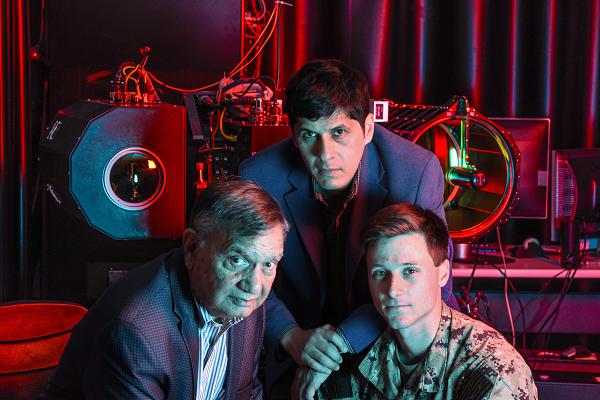
Monterey, California. (February 22, 2025): There is a special place where the U.S. Navy sends its brightest minds, and the things they come up with are mind boggling. In this photo by Javier Chagoya, three of these advanced thinkers (from left to right) Dr. Leonardo Herrera, Dr. Jae Jun Kim, and Dr. Brij Agrawal show off their latest effort to develop lasers that use artificial intelligence to track and target unmanned aerial vehicles.
Why lasers?
Most sci-fi enthusiasts think lasers destroy a target using short blasts of energy lasting only milliseconds. The reality is the ability of a laser to destroy a target is driven by how powerful it is and how long it is focused on a target. This latest project attempts to use artificial intelligence to improve the tracking and targeting of multiple drones simultaneously, quicker, and more accurately than a human operator. The study involved creating accurate simulations of drones in flight taken from thousands of images collected by the team. These photos were used to create a targeting model with AI assistance which was then laboratory tested.
- Details
- Hits: 1131
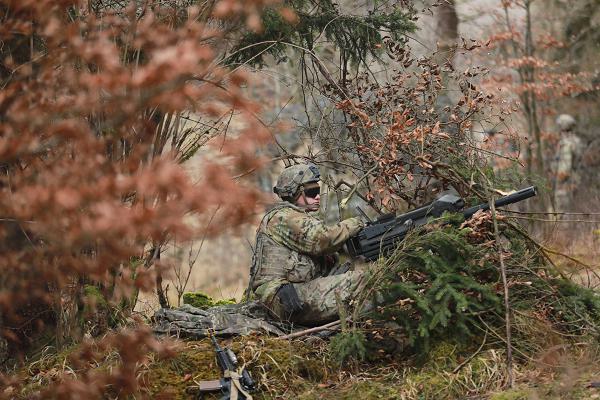
Hohenfels, Germany. (February 21, 2025): In World War II, GIs had a saying “grenades are great if you can get close enough. The trouble is getting close enough.” In the old days, infantrymen had to creep within throwing range and there was always the danger the enemy would throw them back. How things have changed. In this photo by Staff Sergeant Tristan Peete, Specialist Zachery Curtiss fires an M-19 automatic grenade launcher, a devastating weapon that earlier warriors could only dream of.
The M-19’s roots date to Vietnam when the Navy employed them on riverine craft patrolling the Mekong Delta. A handheld version, the M-209, was widely employed by infantry platoons and was the frontrunner to today’s fully automatic belt-fed launchers.
- Details
- Hits: 1245

Parris Island, South Carolina. (February 14, 2025): For junior enlisted troops, there is a big difference between being “in” a formation and standing in front of one. When you are in front of the formation, there is no place to hide. In this photo by Lance Corporal Ayden Cassano, Corporal Ava Alegria aims a rifle during a Corporals Course culminating event. The course is designed as a transition between the junior enlisted ranks and leadership positions.
Corporal is the first rung of the non-commissioned officers’ ladder and represents Marine leadership at the most basic level. The Corporal’s Course is a three-week program that teaches basic requirements while allowing for additional curricula tailored to meet the needs of individual units. Passing the course is a requirement for promotion to sergeant.
- Details
- Hits: 1283
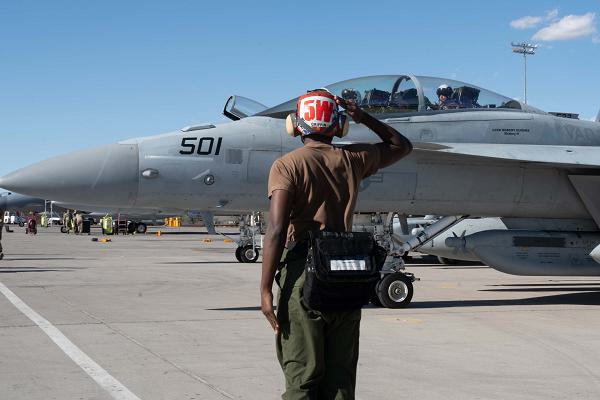
Nellis Air Force Base, Nevada. (February 5, 2025): In the fifties and sixties, the U.S. military seemed to believe that close quarter aerial combat, or dogfighting, was a thing of the past. Advances in long range missile technology, it was believed, would replace the need for fighter jocks. American pilots paid the price over the skies of Vietnam, suffering “unacceptable” losses of nearly one-to-one. One of the primary reasons for this disparity was a lack of realistic one-on-one air combat training.
In this photo by Senior Airman Jordan McCoy, Petty Officer 3rd Class Keyon Griffin salutes an EA-18G Growler aircraft as it taxis out to support Exercise Red Flag-Nellis 25-1. The exercise is part of a series of two-week advanced aerial combat training sessions held several times a year. The goal is to develop and assess the ability of allied pilots to fight and win one-on-one encounters with the enemy. This effort began in 1972 with the creation of the Air Force’s special Aggressor program and the first Red Flag exercises followed a few years later.
- Details
- Hits: 929
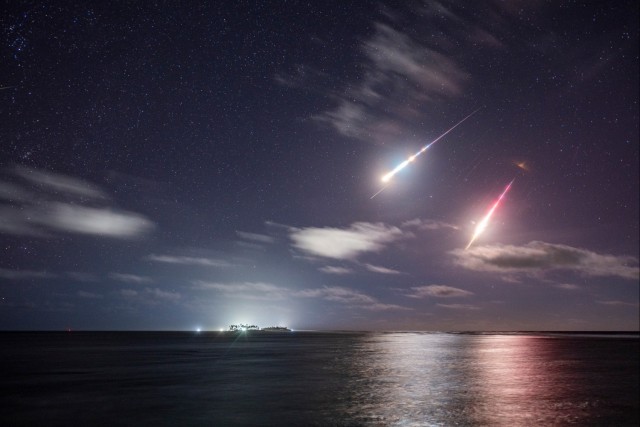 An unarmed Minuteman III Intercontinental Ballistic Missile launches during the Glory Trip-252 operational test on Feb. 19 from Vandenberg Space Force Base, California. ICBM test launches demonstrate the readiness, reliability and effectiveness of the U.S. nuclear deterrent, ensuring national security in an era of strategic competition. This routine test validates the accuracy and performance of the weapons systems. (U.S. Army photo by Sherman Hogue)
An unarmed Minuteman III Intercontinental Ballistic Missile launches during the Glory Trip-252 operational test on Feb. 19 from Vandenberg Space Force Base, California. ICBM test launches demonstrate the readiness, reliability and effectiveness of the U.S. nuclear deterrent, ensuring national security in an era of strategic competition. This routine test validates the accuracy and performance of the weapons systems. (U.S. Army photo by Sherman Hogue)
REDSTONE ARSENAL, Ala. - A U.S. Army Space and Missile Defense Command team played an important behind-the-scenes role in supporting the Air Force’s Glory Trip-252, Feb. 19.
An unarmed Minuteman III intercontinental ballistic missile launched from Vandenberg Space Force Base, California, during Air Force Global Strike Command’s operational test and impacted in a pre-established target zone roughly 4,200 miles away near USASMDC’s Ronald Reagan Ballistic Missile Defense Test Site on Kwajalein Atoll in the Republic of the Marshall Islands. RTS is a range and test facility located halfway between Hawaii and Australia.
Read more: RTS PROS SUPPORT AIR FORCE GLORY TRIP – DEMONSTRATE NUCLEAR FORCE READINESS


